Poly grads’ median monthly income hits S$2,900 in 2024, but full-time employment numbers fall
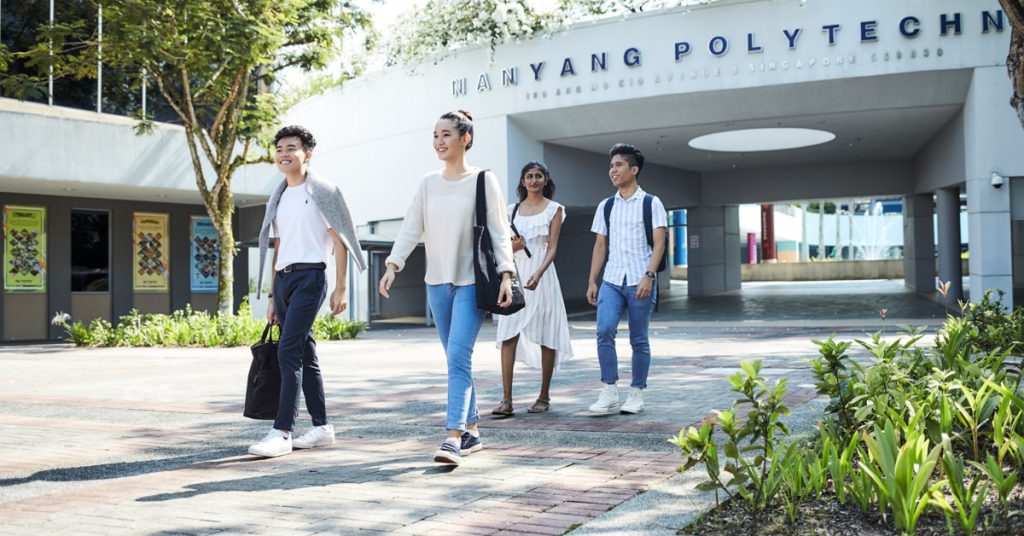
In 2024, fresh out of polytechnic and brimming with ambition, I threw myself into the job hunt.
After applying to jobs a countless number of times, it wasn’t until a year later that I finally landed a position. It looks like I wasn’t the only one facing challenges last year, though.
Fewer polytechnic graduates in Singapore secured employment in 2024, according to the latest Graduate Employment Survey (GES) released on Jan 13, 2025.
However, more of them received higher pay, with humanities graduates commanding the highest salaries across the different courses.
Worrying unemployment rate
According to the survey, 87.5% of polytechnic graduates in the workforce found permanent, freelance, or part-time jobs within six months of graduation or after completing full-time national service.
This marks the first time the figure has slid below 90% since 2020, amid COVID-19 disruptions to the job market.
Only 54.6% of the graduates secured full-time permanent jobs in 2024, compared with almost 60% in 2023 and 59% in 2022.
5.9% were freelancing and 27% were in part‐time or temporary employment. As in previous years, about half of the latter indicated that they were pursuing or preparing to begin further studies.
Worryingly, the unemployment rate of fresh polytechnic graduates sharply rose from 7.3% in 2023 to 12.5% in 2024—a figure comparable to the 12.6% recorded in 2020 during the height of the pandemic.
This underscores a challenging labour market for fresh graduates despite Singapore’s 4% economic growth in 2024, a marked improvement from 1.2% in 2023.
But higher salaries
There is some good news, though.
Despite the decline in job placements, salaries have been rising for those employed.
The median gross monthly salary for graduates in full-time permanent jobs was S$2,900—a S$100 increase from last year.
Humanities and social sciences graduates led the way with a median salary of S$3,038, followed by health sciences and information and digital technologies graduates, both earning S$3,000.
Meanwhile, arts and sciences grads rounded up the bottom, producing graduates with a median salary of S$2,625 and S$2,600 respectively.
Equipping students with necessary skills
Despite the declining employment rates, Dr Maliki Osman, Second Minister of Education, responded to the survey results with optimism.
In a Facebook post on Jan 13, he shared that the GES survey showcases graduates’ “resilience and adaptability in an ever-changing world.”
“It’s encouraging to note that our graduates are commanding higher salaries across various sectors.”
On the other hand, Mr Soh Wai Wah, Principal and Chief Executive of Singapore Polytechnic, acknowledged the evolving landscape, stating that the institution is actively working to equip students with the skills and adaptability needed to navigate the job market.
“This includes strengthening industry partnerships to provide real-world experience, integrating AI (artificial intelligence) literacy into our curriculum, and enhancing career guidance and support services,” he added on behalf of the Polytechnic Graduate Employment Survey committee.
- Read other articles we’ve written about Singaporean startups here.
Also Read: Singapore salary data: 200+ non-executive roles that pay S$10,000 per month or more
Feature Image Credit: NYP via Facebook
Your next Grab ride could be in a BYD: Tech giants team up to roll out 50,000 EVs in SEA
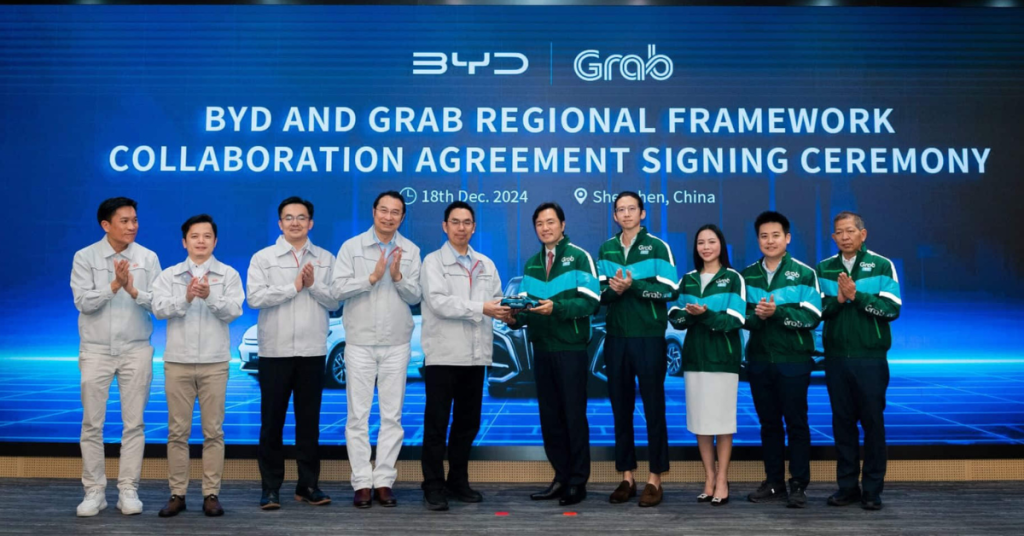
Grab is teaming up with Chinese automaker BYD to roll out up to 50,000 BYD electric vehicles (EVs) to its driver-partners across Southeast Asia.
This collaboration aims to drive the adoption of green vehicles while addressing the hurdles of high upfront costs that have hampered EV growth in the region, said both companies in a press release.
But what does this mean for Grab users and drivers? Let’s dive into the details.
Paving the way for green rides
Southeast Asia has long struggled with the transition to EVs due to financial and infrastructural barriers. By introducing a large fleet of BYD EVs, Grab hopes to make sustainable transportation more accessible to its driver-partners and passengers.
While the company has already launched EV-specific e-hailing services in markets like Indonesia, Singapore, and Thailand, there’s no word yet on when this will expand to other countries, including Malaysia.

Grab’s lineup of BYD vehicles includes popular models like the Atto 3, Seal, and M6. Notably, the collaboration also features the luxurious Denza D9—a seven-seater electric MPV that could redefine premium ride-hailing in the region. For Malaysia, this might mean elevating the existing Grab Premium or Exec services, but details remain under wraps.
What’s in it for Grab drivers?
Grab’s driver-partners can rent these BYD EVs from fleet partners or finance them through Grab’s car ownership scheme.
To sweeten the deal, extended warranties for high-voltage batteries are included, addressing one of the major concerns drivers might have about EV reliability.
In countries like Singapore and Thailand, passengers can already opt for an “Eco-friendly Ride” at no extra cost.
This feature ensures green vehicles are prioritised, providing an added incentive for drivers to switch to EVs while reducing the region’s carbon footprint.
A marriage of technology and transportation
This partnership isn’t just about putting more EVs on the road. Grab and BYD are also integrating technology to enhance the driver and passenger experience.
BYD vehicles will come equipped with Grab’s driver app directly integrated into the vehicle’s head unit. Drivers can access job notifications, navigation, and chats on a larger screen, eliminating the need to switch between their phones and other devices.

This intuitive setup not only streamlines operations but also improves safety on the road.
Telemetry data from BYD vehicles will feed directly into the Grab platform, providing insights into driving patterns and external conditions.
For instance, weather and traffic data collected through wiper signals and travel speeds can help Grab guide drivers to high-demand areas, ensuring efficient resource allocation during peak hours. This data-sharing initiative could also result in more accurate estimated arrival times (ETAs) for passengers.
-//-
As someone who has long rooted for sustainable innovation, it’s good to see Grab and BYD taking such a significant step toward mainstreaming EVs in the region.
However, the success of this initiative hinges on infrastructure support, such as accessible charging stations and affordable financing options for drivers.
That said, by addressing the key barriers to EV adoption and leveraging cutting-edge technology, it looks like Grab is not just reshaping its fleet but also paving the way for a greener, smarter future.
- Learn more about Grab here and BYD here.
- Read other articles we’ve written about Malaysian startups here.
Also Read: Inside the exclusive programme for startups by Grab Malaysia, GXBank leaders & Endeavor Malaysia
Featured Image Credit: Grab
This S’porean never intended to sell the arcade machines he made, now it’s his side hustle

For Poh Keng Jin (KJ), nostalgia is more than a feeling—it is a craft.
Having spent plenty of his childhood days battling it out on Street Fighter at arcades, he sought to recreate those sentimental memories by building his own retro gaming machines.
KJ’s journey started when a friend introduced him to the Raspberry Pi, a credit-card-sized, budget-friendly computer that could be used to run retro games.
Since then, he has created a range of machines, including digital pinball tables, and turned his passion into a side hustle with RetroCade, offering workshops for Singaporeans eager to build their own retro machines.
Selling wasn’t his intention
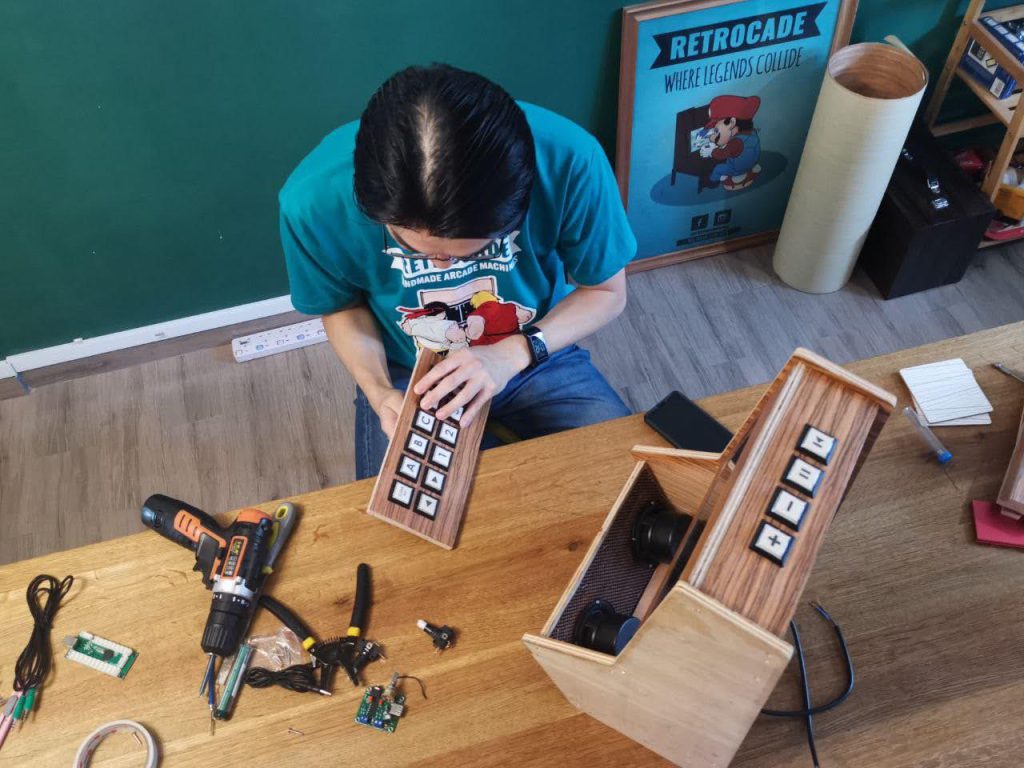
Initially, KJ did not intend to sell the machines he had built. His first creation, a clunky prototype he constructed in late 2015, was more of a personal project than a product.
With a background in 3D design, KJ could easily visualise his creations and draw up the blueprints for his gaming machines, but the real challenge laid in mastering the electronics.
I was totally clueless about the wiring for the controls. [For my] first machine, I actually bought a full controller, dismantled and transferred the joysticks, buttons and everything else into my machine. From then on, I was able to figure out what’s what.
Poh Keng Jin, founder of RetroCade
It wasn’t until a year later that KJ dismantled the first machine and built a “sleeker second version,” as he shared in an interview with AsiaOne.
In 2016, he brought his machine to several game conventions to showcase the game that he had developed for it. It was there that he realised he could turn his hobby into a side hustle, when attendees began asking if they were for sale.
Passing on his skills
As KJ built more machines, he streamlined his designs to make them easier to construct.
He then realised that with the right kit and hands-on guidance, anyone could build their own game machines, leading him to start offering workshops through RetroCade.
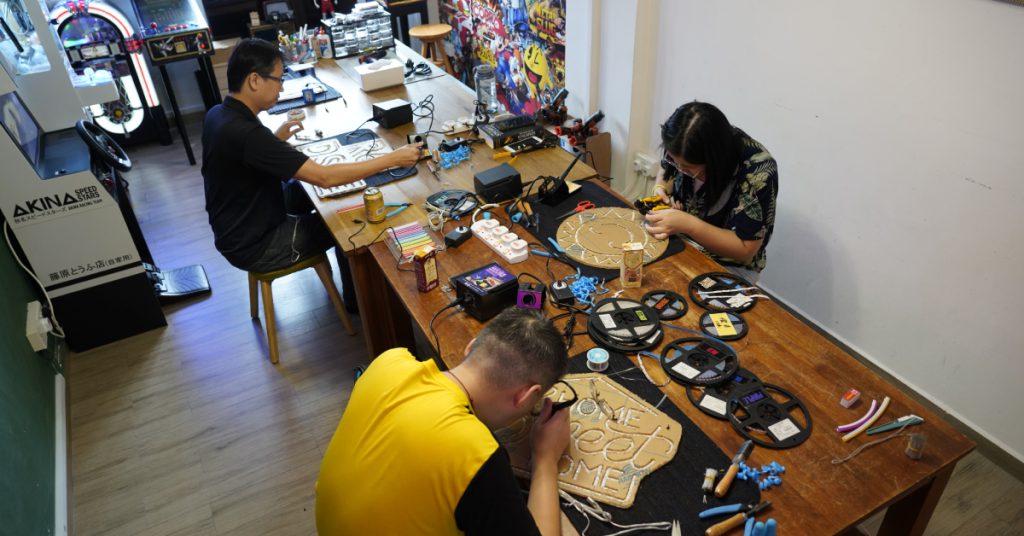
KJ hosted his first workshop at Chye Seng Huat Hardware Coffee Bar, promoting it through flyers at the café and posts on various social media platforms.
Sign-ups filled up quickly, but as the workshop was held in an external location, he had to take extra care to conduct thorough checks, ensuring no arcade machine parts were left behind.
The arcade machine has so many parts. I had to triple check everything to make sure that I didn’t miss out on any detail. Thankfully it went without a hitch.
Poh Keng Jin, founder of RetroCade
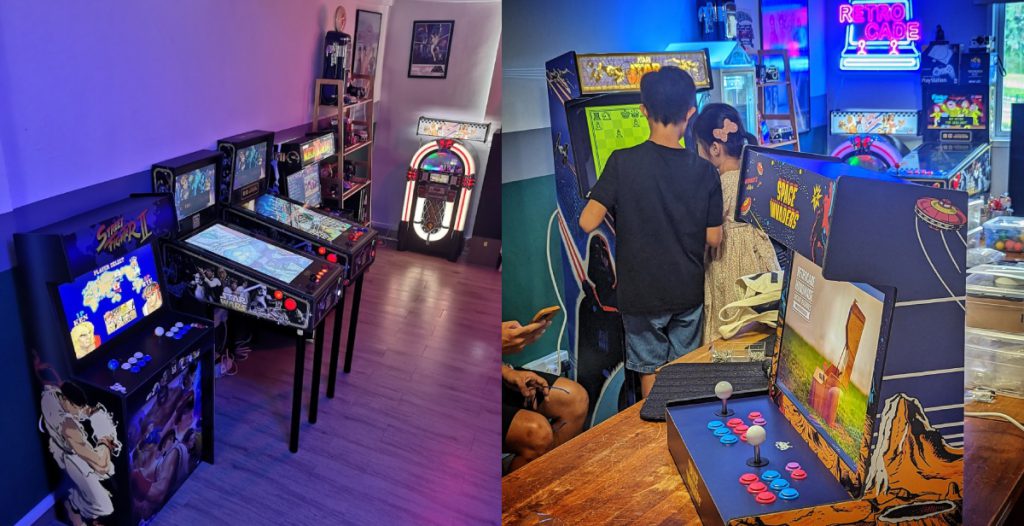
KJ now hosts his workshops in a cosy two-storey HDB unit in Woodlands. Prices for different machines are as follows: S$500 for single-player machines, S$900 for two-player tabletop machines, and S$750 for jukeboxes.
Participants will receive all the necessary tools, including hand drills and screws, along with pre-cut wooden panels to assemble the gaming console.
They are also provided with an instruction booklet which offers step-by-step guidance on every aspect, including wiring the Raspberry Pi processor to physical controls like joysticks and buttons.
When asked about the initial costs of launching these workshops, KJ explained that it didn’t require a substantial upfront investment. When he first began, he didn’t purchase parts until someone placed an order.
“But as I got a more steady stream of workshops, I started to stock a few sets so that the lead time will not be so long,” he added.
Apart from retro arcade machine workshops, RetroCade also offers sessions where you can design your own neon signs. “The neon signs are something I have always wanted to have for myself,” he shared.
“You can see the pattern here—the things I made are actually what I wanted for myself.”
Just a fun side hustle for now
KJ’s retro machines have gained attention at local gaming conventions like GameStart, as well as international ones such as BitSummit and Gamescom.
He has even collaborated with Uniqlo for a Marvel-themed launch in 2019, placing custom-made machines at Orchard Central and VivoCity.
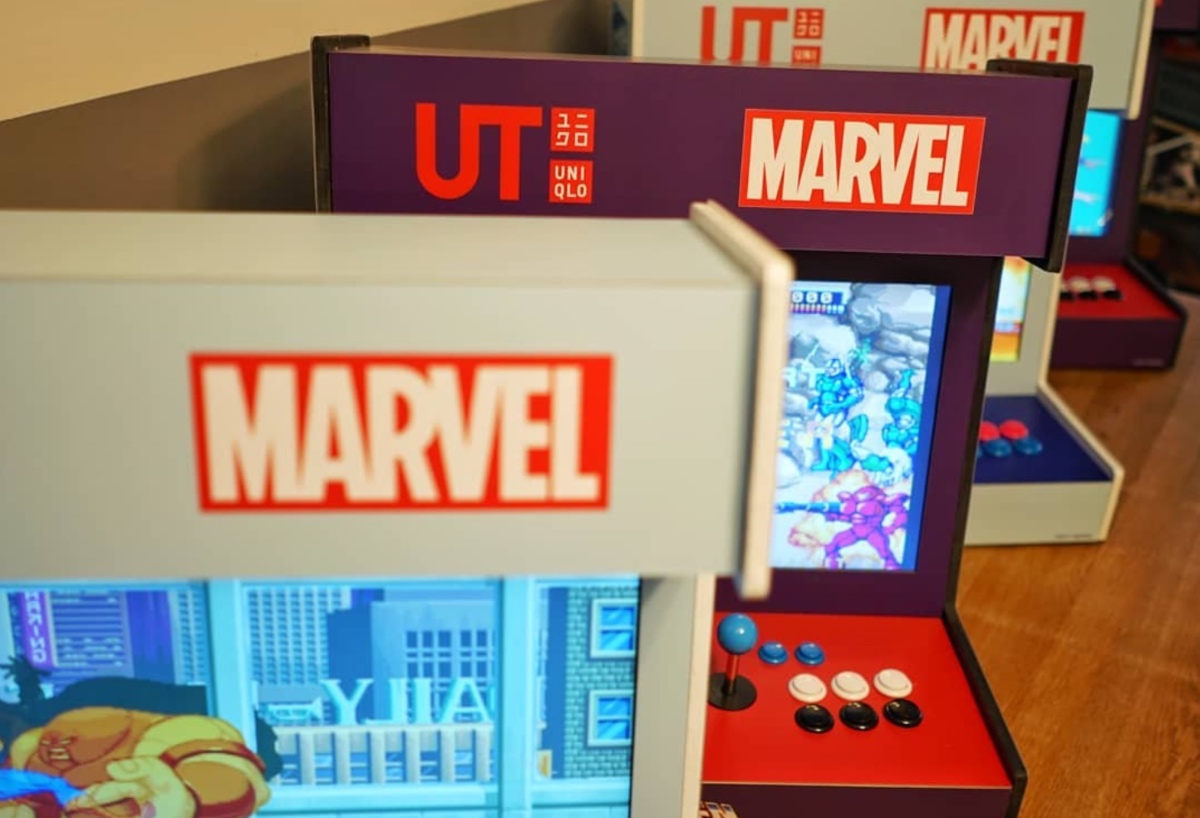
Despite seeing growth, KJ does not intend to turn RetroCade into a full-fledged business. He finds that the demand is not big enough for him to start doing it full time just yet, and enjoys the fact that he is doing it for fun.
It’s something I started on a whim for fun, and hope to continue to have fun with it.
Poh Keng Jin, founder of RetroCade
With no concrete plans ahead, KJ aims to keep building retro machines and hosting workshops.
He shared that he is especially keen on conducting more school workshops, having already worked with primary schools, secondary schools, ITEs, and polytechnics.
For now though, KJ’s goal is to create at least one new retro design each year. “If one day the demand is strong enough, I may make it an actual business.”
Also Read: This S’porean started a bakeshop while working in PwC, now it’s grown to 3 outlets in a year
Featured Image Credit: RetroCade
Greener roads, safer walks: These 10 S’pore areas will be pedestrian-friendly streets by 2026
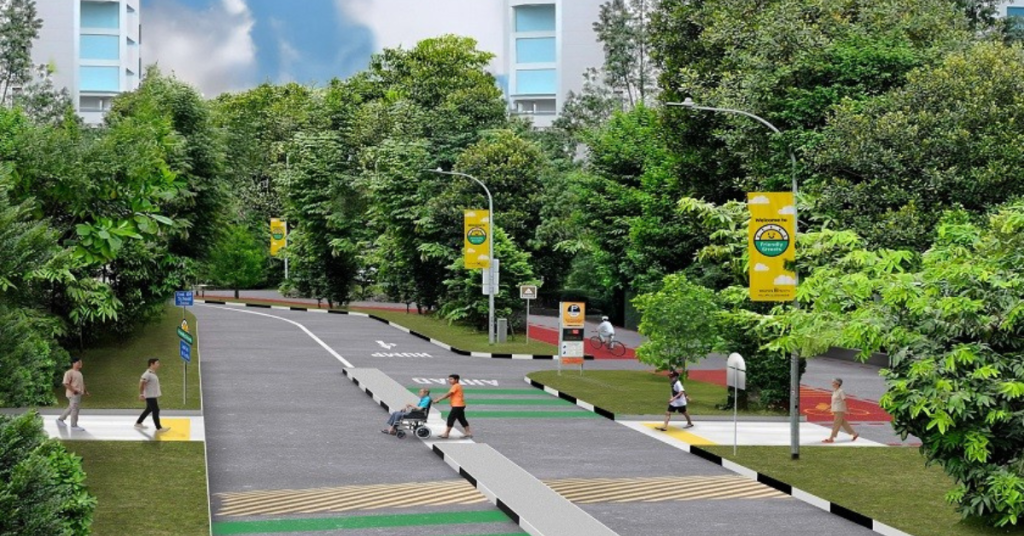
Singapore is taking a significant step towards becoming a more pedestrian-friendly city. By 2026, 10 key areas across the island will be transformed into “Friendly Streets,” a move announced by the Land Transport Authority (LTA) on January 14.
This initiative will see construction starting in the first half of 2025, focusing on making streets safer, greener, and more inclusive for pedestrians and cyclists alike.
Here’s why this will be important for Singapore’s commuters.
What are Friendly Streets?
Singaporeans have long relied on public transport, walking, and cycling as primary modes of commuting. With the island’s robust MRT network and bus services, many find it convenient to ditch cars altogether.
However, the current road infrastructure often prioritises vehicles, making it challenging for pedestrians and cyclists to navigate certain areas.
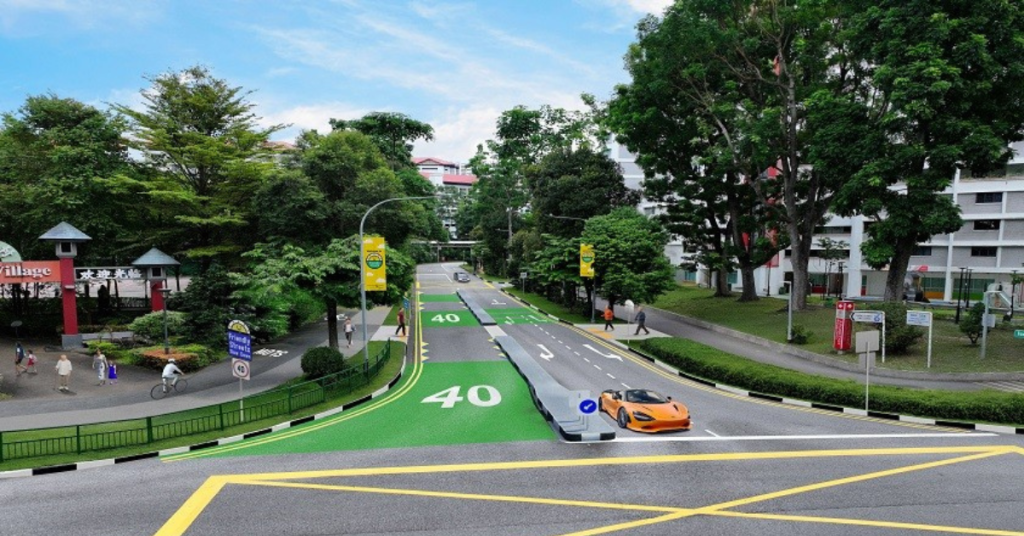
The Friendly Streets initiative aims to revamp selected high-traffic areas to prioritise pedestrians and cyclists over vehicles.
These streets will feature barrier-free crossings, raised zebra crossings, and green-coloured road surfaces to encourage drivers to slow down. The project also includes road humps and extended green man crossing times to make commuting safer for seniors and children.
Based on the LTA website, locations were chosen based on high pedestrian flow and proximity to essential amenities such as markets, MRT stations, and schools. The 10 estates selected are:
| Locations | Roads |
| Bedok | Bedok North Street 2 (0.9 km) |
| Buangkok | Buangkok Cresent (1 km) |
| Bukit Panjang | Bangkit Road / Bukit Panjang Ring Road / Pending Road (1.2 km) |
| Choa Chu Kang | Choa Chu Kang Avenue 2 (0.7 km) |
| Holland / Buona Vista | Holland Avenue / Drive, Holland Village Way, Lorong Liput (2 km) |
| Jurong East | Jurong East Street 24 (0.7 km) |
| Pek Kio | Owen Road, Cambridge Road, Kent Road, Dorset Road, Gloucester Road (1.7 km) |
| Punggol | Punggol Drive (1.7 km) |
| Sembawang | Admiralty Drive, Sembawang Drive / Way / Vista / Alley (1.6 km) |
| Tiong Bahru | Havelock Road (between Zion Road and Lower Delta Road) / Indus Road (1 km) |
Each estate will receive tailored features to address its own needs, ensuring a localised approach to enhancing urban mobility.
Why it matters
The Friendly Streets initiative isn’t entirely new. It began in 2023 with pilot projects in five towns: Ang Mo Kio, Bukit Batok West, Tampines, Toa Payoh, and West Coast.
With the exception of Tampines, the pilots in all the towns have been completed.
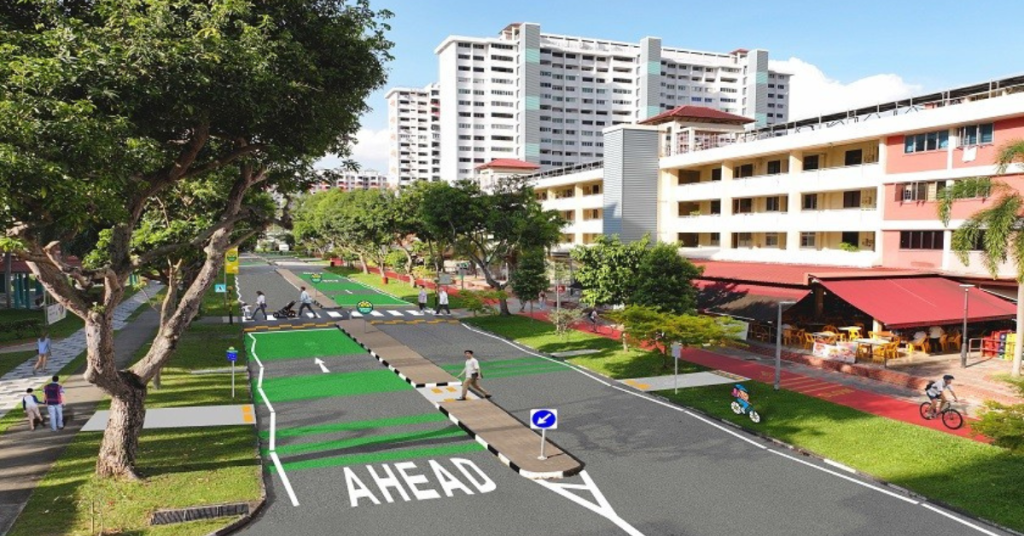
According to the LTA, these pilots have been well received, with nine out of ten residents reporting improved walking and cycling experiences.
The Friendly Streets initiative is part of a larger effort by the LTA to make Singapore less vehicle-centric. By redesigning roads to prioritise pedestrians and cyclists, the city-state is taking tangible steps towards a car-lite future.
As someone who frequently uses public transport, I’ve noticed a growing appreciation for pedestrian-friendly infrastructure. It’s heartening to see Singapore actively investing in solutions that promote sustainability and inclusivity.
While there’s still work to be done, the future looks promising. With more streets becoming pedestrian-friendly, Singaporeans can look forward to safer, greener, and more enjoyable commutes.
Let’s hope that this initiative will also inspire more cities to rethink their approach to urban mobility. After all, a walkable city is a liveable city.
Also Read: Inside the exclusive programme for startups by Grab Malaysia, GXBank leaders & Endeavor Malaysia
Featured Image Credit: Land Transport Authority
VP Eats Out: We tried Oversea Group’s 2025 CNY menu at its new palace-themed restaurant
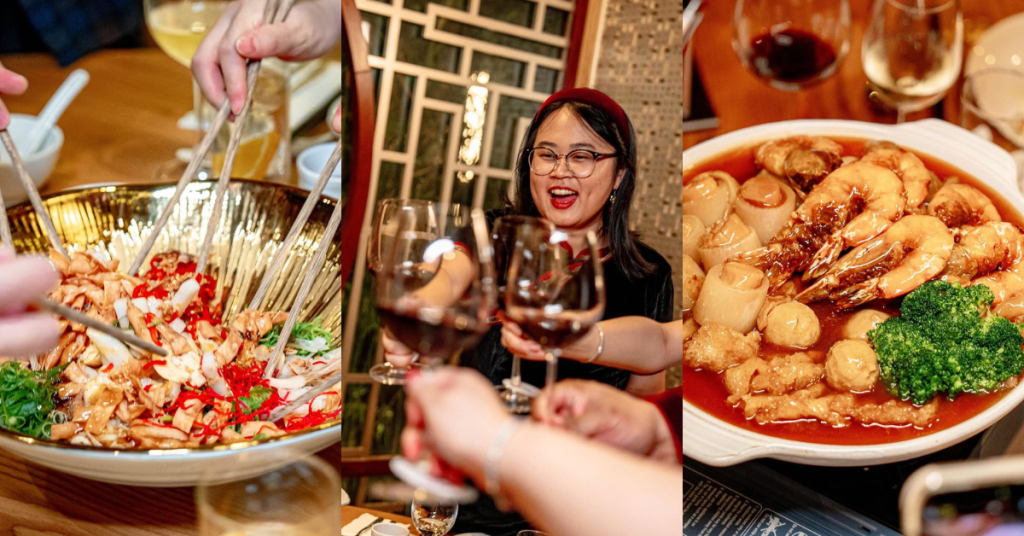
As we welcome 2025, we’ll also be greeting a new Chinese zodiac very soon: the snake.
Based on the Chinese zodiac, the snake is associated with wisdom, charm, and elegance—the latter two of which can be used to describe Oversea Group’s Chinese New Year 2025 spread.
In conjunction with the opening of its newest outlet called Oversea Palace Seafood, the Vulcan Post team was invited to a preview of this seasonal feast.
I wasn’t sure what to expect as CNY meals in my family are kept quite humble. My mum would typically prepare homey fish maw soup, bamboo shoots soup, steamed fish, and poon choi.
But walking into Oversea Palace Seafood with its palace-themed ambience, I had a feeling this feast would be a grand affair. Spoiler alert: it did not disappoint.
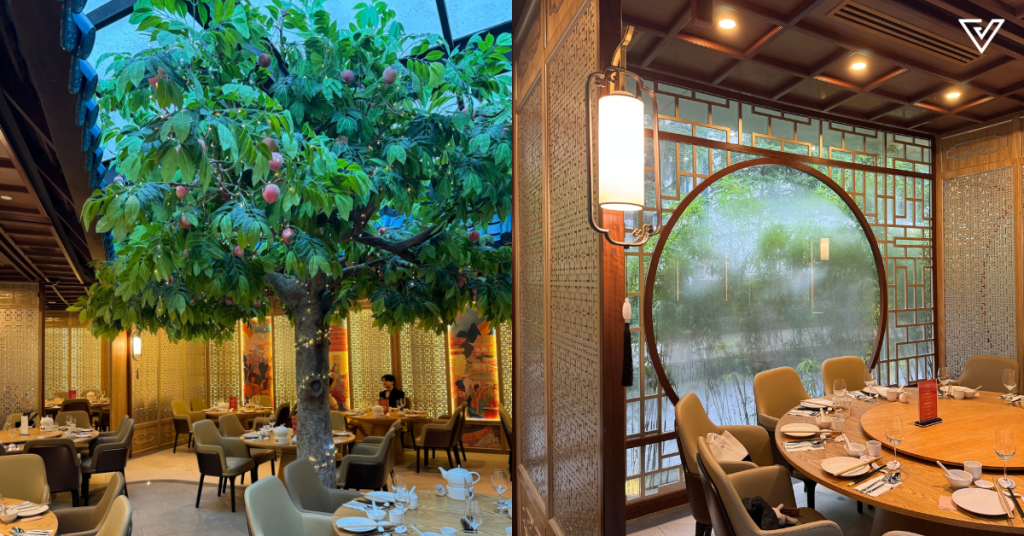
It’s not a Malaysian CNY without yee sang
As local customs dictate, a Malaysian CNY feast typically starts with the popular yee sang to reign in a prosperous year.
At Oversea Restaurant this year, its Yee Sang with Abalone and Korean Snow Pear is a more elevated version of what I’m used to.
Featuring ingredients like colourful shredded vegetables, pickled ginger, pomelo, and the two star ingredients, each ingredient carries a special meaning. For example, cucumber symbolises many happy returns and the crispy pok chui crackers symbolise gold bars.
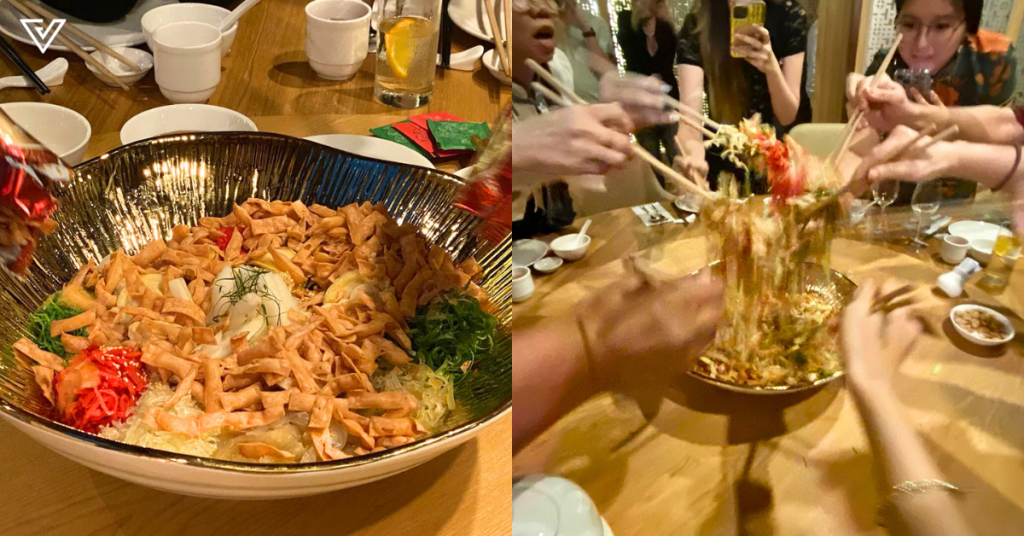
Abalone, on the other hand, carries the same significance as salmon in your usual yee sang. It’s called “baoyu” in Mandarin, which is a homonym for abundance.
Korean Snow Pear isn’t part of a traditional lou sang toss, but it added a subtle sweetness and refreshing taste to the overall dish.
After many “Huat ah!” and other well wishes, the real feast began.
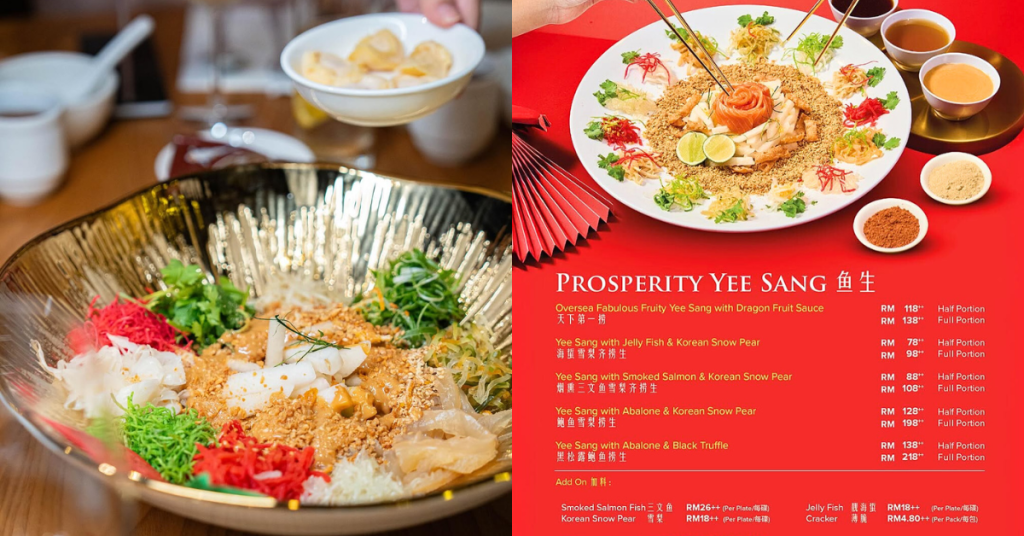
Fun fact: There are various types of Yee Sang available for takeaway and dine in, with prices starting from RM78++ for half portion and RM98++ for full portion.
Classic dishes with refined flavours
In true CNY fashion, Oversea Restaurant carefully curated each dish to reign in a new year of prosperity. After all, is it really a culturally significant dish if there’s no symbolism to it?
The Golden Fish Maw Kampung Chicken Soup, a staple in my home, had a rich broth. We’re not sure how long it was boiled for but the flavours can attest that it’s certainly more than a couple of hours.
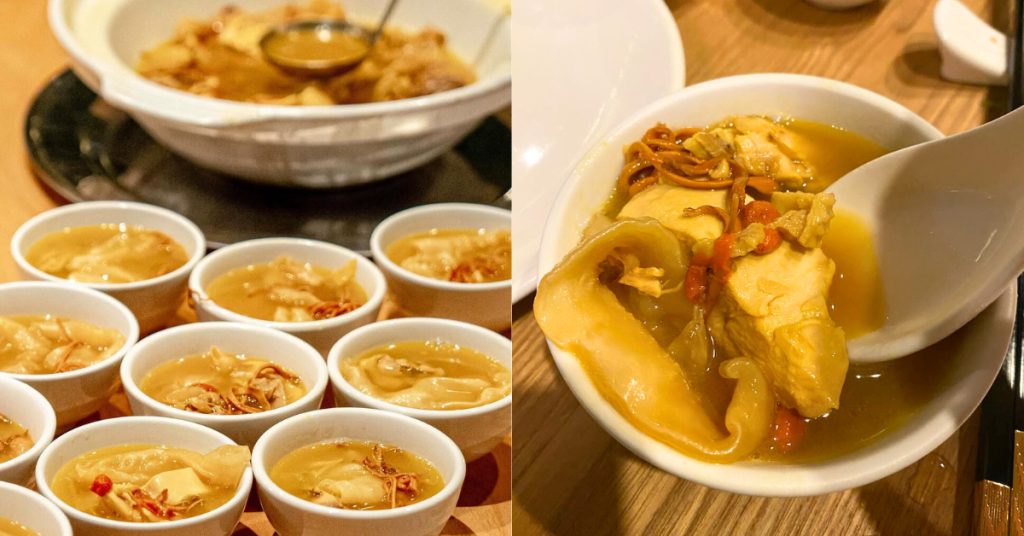
Symbolically, chickens are served whole during the festivities as it represents family unity and togetherness. But we’ll turn a blind eye to Oversea Restaurant’s half chicken as one pot of this was more than generous for our table of nine.
The Hong Kong-Style Claypot Waxed Meat Rice (or better known as lap mei fan) is an equally common sight during the festive season.
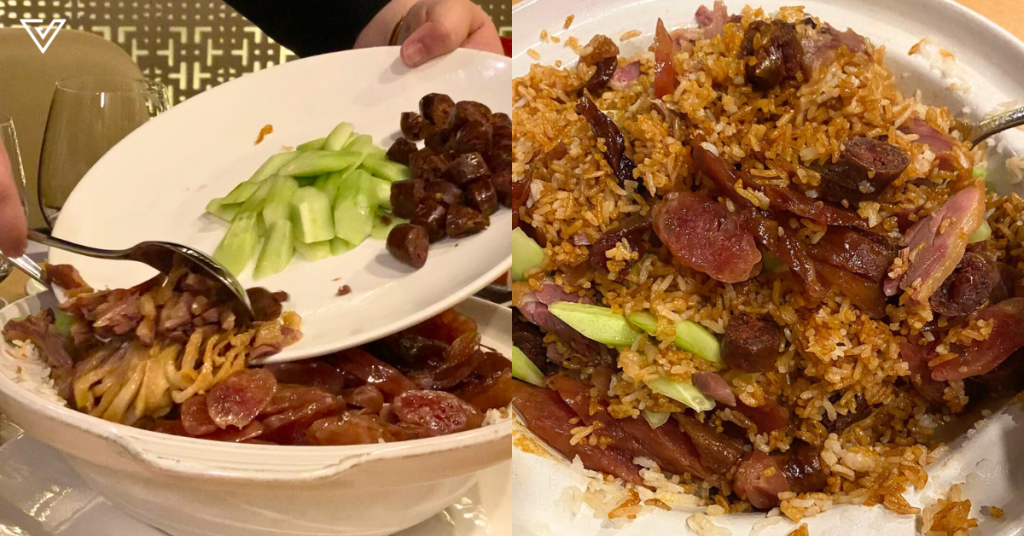
Topped with Chinese waxed pork sausages, liver sausages, and duck sausages, the dish has a distinctive aroma and strong taste. If you like lap cheong, you’ll surely enjoy this.
It’s said that this Cantonese dish is carried over from pre-refrigeration days, back when ancient Chinese citizens preserved meat for winter. As spring and CNY approaches, they’d celebrate by feasting on this claypot delicacy.
The final main course is one that perhaps best represents the festive season with its complex yet harmonious flavours thanks to layers upon layers of ingredients.
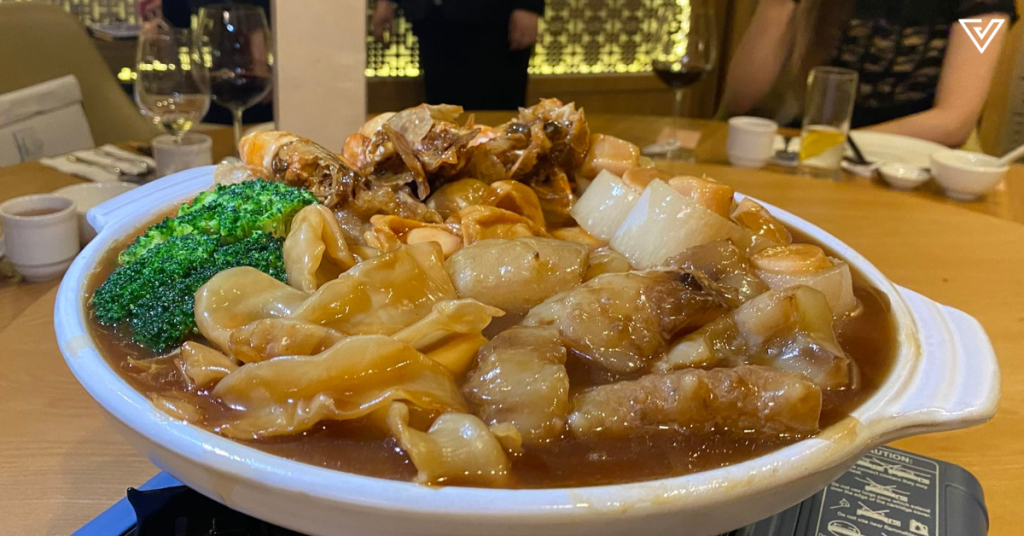
Oversea Restaurant’s Prosperity Treasure Pot was loaded with different elements, as what you’d expect a classic poon choi to be.
You have the tender scallop, chewy sea cucumber and fish maw, fragrant chicken, large abalones and prawns, and more. All of them have their own unique taste that combines together to create an umami medley on your tongue.
Fun fact: The Hong Kong Style Claypot Waxed Meat Rice and Prosperity Treasure Pot are also available for takeaway and delivery with prices starting from RM68++.
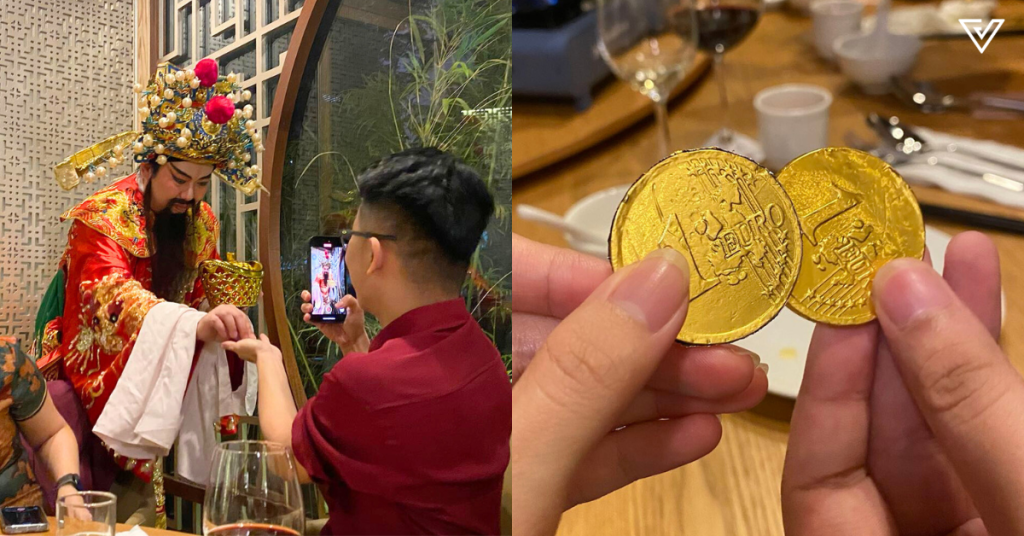
Desserts consisted of Fortune Nian Gao (another classic dish) and Chilled Yuzu Longan with Nata de Coco, giving a sweet and refreshing end to the overall night.
-//-
If you’re looking for CNY snacks, Oversea Group is also offering jars of treats to bring home:
- Pineapple ball (20 pieces for RM33.90 nett)
- Oriental muffins (25 pieces for RM39.80 nett)
- Egg rolls (15 pieces for RM28.80 nett)
- Pineapple Yogurt Cookies (21 pieces for RM33.90 nett)
Under the Oversea Group, there are six Oversea Restaurant outlets: Imbi, Sri Petaling, 1Utama, Genting, Ipoh, and Menara Lien Hoe in PJ.
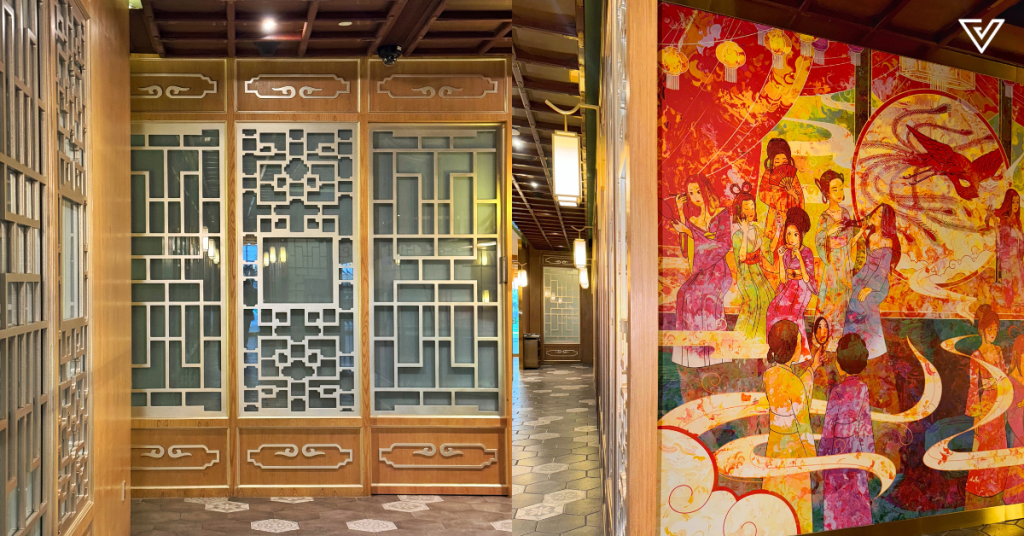
Each of these outlets has different variations in their CNY 2025 offerings, but the dishes mentioned are festive highlights. This seasonal menu is available from now until Chap Goh Mei (February 15, 2025). Tables can be reserved by contacting the respective outlets here.
Also Read: 5 insider insights from Cradle’s PLUGIN conference that M’sian entrepreneurs should know
Featured Image Credit: Oversea Group